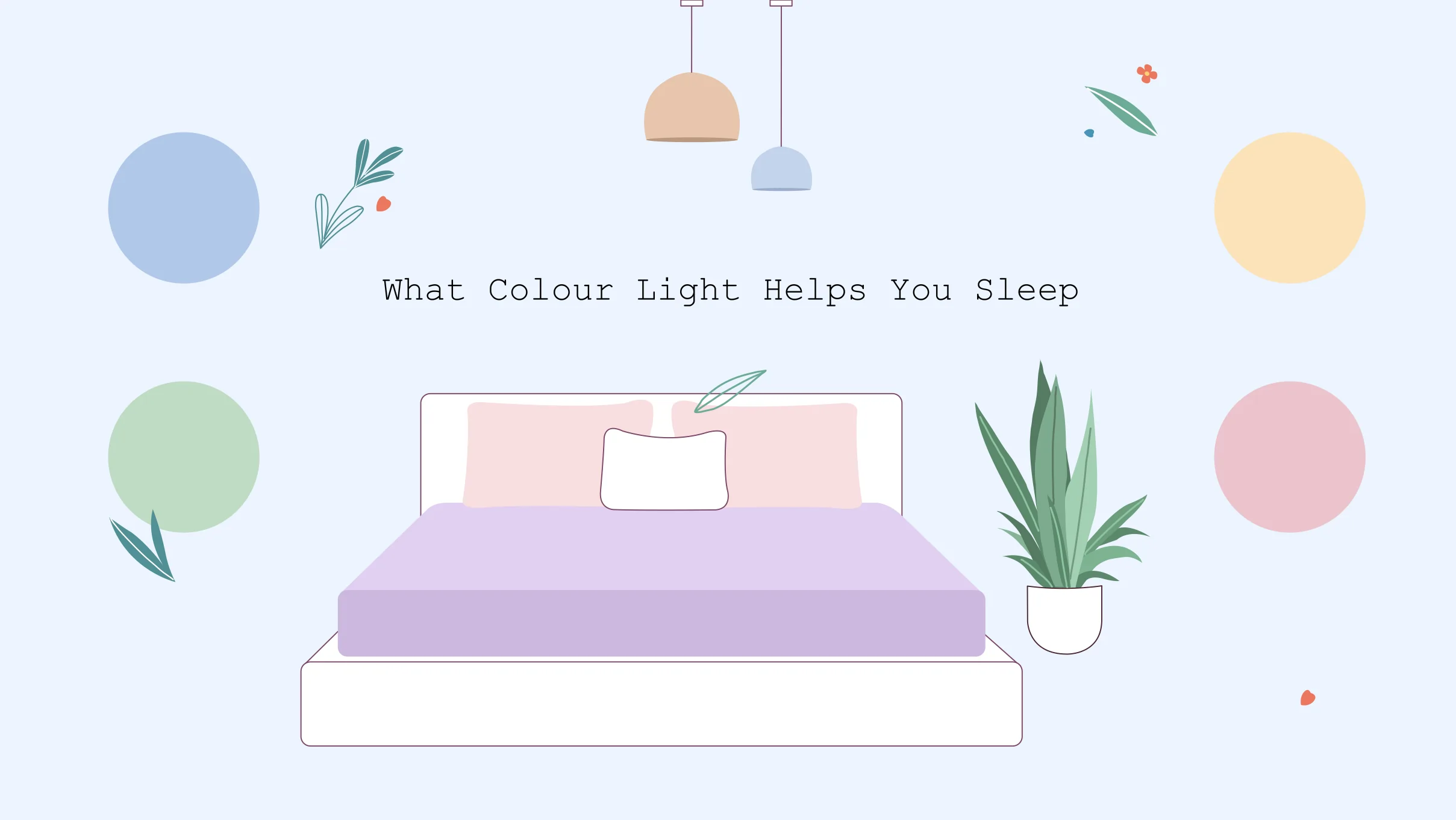What Colour Light Helps You Sleep?
Written by


One day, a professor asked her students, ” Does anyone know what colour light helps you sleep?” Most students replied that sleep and colour are entirely contrasting and that bright lights should always be avoided before bed. But, the professor replied something interesting “You people are partially right, but it has turned out that certain lights help in sleeping better, and one of them is red.” The students were surprised as to how light can help sleep better.
The professor explained in detail that while we sleep, our body’s natural sleep-wake cycle is greatly controlled by the hormone melatonin. And, there are specific photoreceptors in our eyes that deliver back information to our brains, eventually controlling the melatonin levels. To know more about what colour lights help you sleep, keep reading.
What Colour Light Helps You Sleep?
Light therapy is crucial in controlling insomnia and enhancing our mood, wellness, and cognition. It is vital to determine how we perceive our surroundings and the world. The presence of light helps in interpreting the environment. Therefore, light is associated with circadian rhythm and the sleep-wake cycle of a human’s body. The brightness, saturations, and lack of it affect your melatonin production and prepare the body for bedtime. This means the type of light you have in your bedroom has the power to make you sleepier or alert based on colour, brightness, hue, and saturation.
The simplest way to understand how colour psychology affects sleep is given below-
- White or Blue Light: Blue or white light colours or colours of this type promote alertness in the brain, and increase the tendency of wakefulness if exposed right before bedtime. This occurs because our brain cells are more sensitive to blue wavelengths.
- Red or Amber Light: A red or amber colour light is likely to promote sleepiness since it doesn’t impact the circadian rhythm. Keeping a dim red or amber light will not harm your sleep. Red lights have been associated with melatonin production and provide calmness during the evening. In fact, red light therapy has also been effective in treating depression.
Red Light and Sleep
While some people prefer sleeping in complete darkness, some prefer to sleep in dim light. The second type of people might benefit from red lights. The answer to what colour helps you sleep is Red. Red light wavelengths help the brain produce melatonin, asking the body to fall asleep. The colour red has not been shown to disbalance the circadian rhythm.
Exposing your eyes to the red light in the middle of the night has shown to reap more benefits than blue or green light. But why so? This has been explained in detail by a study in Ohio State University that our retinas carry special photosensitive cells that are responsible for controlling the body’s internal clock. These cells are sensitive to diverse wavelengths of light and colours signalling the brain. Based on this aforementioned study, it has been found that the brain is most sensitive to blue or green lights, providing daytime alertness.
In a 2012 study of twenty female athletes, researchers investigated the efficacy of red light treatment. Participants were randomly designated to undergo red light treatment for 30 minutes each night for 14 days. As a result, the participants demonstrated a high quality of sleep, melatonin levels, and endurance compared to a placebo group who did not receive light treatment.
Benefits of Red Light for Sleep
A lot has been talked about red light and sleep. Let us understand in detail the benefits offered by a red light for sleep.
1. It Balances Circadian Rhythm: Our body’s normal sleep and waking cycles are governed by our circadian rhythm. Since it helps us create melatonin, research has demonstrated that red light therapy may assist our bodies in building a steady circadian rhythm, mainly when it’s out of synchronisation.
2. Helps with Sleep Inertia: The grogginess that you often experience right after waking up from sleep is sleep inertia. Sleep inertia leads to a feeling of fatigue and laziness preventing you from hitting the ground in the morning. A study was conducted to understand how red light is associated with treating sleep inertia. A group of sleepers were offered saturated red light through closed eyelids without suppressing melatonin levels, and the result has been positive.
3. Combats the Fear of the Dark: Some individuals may fear darkness, so they keep the lights on while sleeping. However, this light disturbs their sleep. Yet, lighting a red light will keep you asleep and prevent you from fearing the dark. So, red can be a great option if darkness concerns you and you think what colour light helps you sleep.
4. Helps with Night Vision: Red light is non-glaring, unlike the white lights that make you squint for clearly seeing. This is why aeroplane cockpits and submarines mostly use red flashlights.
5. Offers Muscle Relaxation: Red light not only alleviates sleeping but also muscle relaxation. Since red light has an overall relaxing effect on the body, it is believed to calm muscles as well. This release of tension also leads to better sleep.
Blue Light and Sleep
Blue wavelengths might not be suitable for sleep as it suppresses melatonin. Blue light has been associated with sleep disruptions, insomnia, and eye strains. In a study, Harvard scientists and their associates compared the effects of 6.5 hours of exposure to blue light versus green light with similar brightness. The blue light significantly disrupted circadian rhythms and hampered melatonin for approximately twice as long as that of the green light (3 hours vs. 1.5 hours).
The above study throws light on how blue light interferes with your body’s capacity to prepare for sleep far more than any other light. This is because it affects the sleep-inducing hormone melatonin. Hence, if you are thinking about what colour light helps you sleep, then blue isn’t an ideal choice. Also, blue light presence is found in electronic screens, LED lights, and fluorescent lights as well.
But, blue light is beneficial during the day for speeding up response times and improving mood, and concentration.
Most Relaxing Light Colours For Sleep
There are numerous relaxing colours. Some aids in better sleep, some help in waking up, while some help during meditation. Let us study some of the relaxing colours you can put in your room.
- Red: Numerous facts have backed the improvement of sleep under red light. The best way to include red lighting in your daily regime is to fit it into your pre-bedtime routine. You can start by turning on dim red lights, then move to proceed towards your breathing exercises. Practising yoga under red light might also be relaxing before sleep.
- Blue: You might be wondering how blue makes it to the list. The reason is that blue might not be restorative for sleep but is certainly valuable for calming yourself. The best way to enjoy blue light is by creating a starry night, or galaxy night on the ceiling. There are numerous lights available online that will provide a complete planetarium vibe in the comfort of your own place. A 2016 research found that blue light may make cognitive tasks easier for you as it “enhances performances.”
- Pink: Most people admire pink lighting while waking up. The reason is the colour pink offers a relaxing and optimistic feel to the adults, and a fairytale feel to the young adults and children. You can blend in some pink light in your early morning yoga sessions.
- Green: A 2016 University of Oxford research shows that the green light may encourage sleep. The colour green has been associated with concentration. Green colour pierces through darkness better than other colours making it a suitable option for dark work settings.
Conclusion
If you want to have a peaceful sleep and look for what colour light helps you sleep, red light and tones of ambient light are your greatest options. We strongly advise you to avoid blue, unnatural, and bright lights throughout the evening and shortly before bed since they increase attentiveness and wakefulness. Additionally, it blocks the release of melatonin. Red has been the appropriate colour and this is also backed by certain studies.
FAQ
What colour helps you sleep and can be relaxing?
If you are thinking about what colour promotes sleep, it is red. So this is because the red wavelength induces melatonin production that promotes sleep.
Is green light good for sleep?
Yes. If you are on the search for what colour light helps you sleep, then green can be an option. As per studies, green light can promote sleep.
Does blue light keep you awake?
Yes because blue light suppresses the release of melatonin, responsible for making us feel drowsy.
people like this article
Written by








